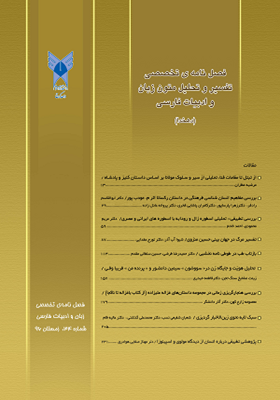تحلیل هویّت و جایگاه زن سووشون « در پرنده من « سیمین دانشور و » فریبا وفی
محورهای موضوعی : متون زبان و ادبیات فارسی
زینت مشایخ سنگ تجن
1
,
فاطمه حیدری
2
*
![]()
1 - دانشجوی دکترای زبان و ادبیات فارسی ،دانشگاه آزاد اسلامی واحد کرج،کرج ,
2 - دانشیار گروه زبان و ادبیات فارسی،دانشگاه آزاد اسلامی,کرج ،کرج، ایران (نویسنده مسئول)
کلید واژه:
چکیده مقاله :
این مقاله به بررسی تصویر ارایه شده از زن در دو اثر ادبیات داستانی مدرن ایران سووشون از سیمین دانشور و پرنده ی من از فریبا وفی می پردازد . بررسی و تحلیل زن در دو اثر فوق با دست یابی زبان و مشخصه های لفظ و محتوا و نیز کاربرد فرهنگ و ایدئولوژی خاص حاکم بر جامعه درباره ی زن ، مورد نظر نگارندگان بوده است . لذا برجسته کردن تصاویر زنان در آثار فوق , بازتاب تجربه ها و عواطف زنانه, نیز انعکاس مصادیق اندیشه های متعصبانه چون تحقیر و استثمار زن ، محدودیت های فردی و اجتماعی ، ترجیح مرد بر زن و هویت باختگی از مضامین مهم آن است . بدین منظور این جستار در یک خوانش ساختار شکنانه با روش تحلیلی- توصیفی به واکاوی این فرهنگ می پردازد که نویسندگان زن معاصر به شدت تمایل دارند که فرد را از دریچه نگاه مردانه رها کنند و چهره ی زنانی را به نمایش بگذارند که خواهان وضعیت بهتری برای خود هستند اما فشارهای بیرونی آنها را مجبور به زندگی بی تحرّک می کند .
This article aims to study the image of women in two Iranian modern novels: Suvašun by Simin Daneshvar and My Bird by Fariba Vafi. The writers have tried to review and analyze the form and the content of the novels as well as the culture and ideology of the society laid on the women as depicted in the two novels. In this regard, a vivid picture of women, the reflection of their feelings and sentiments, the superiority of men over women, the dogmatism imposed on them, their being humiliated and exploited, the individual and social boundaries for them, and their lost identity have been focused on. In an analytic-descriptive method and through a deconstructive approach, the present study has explored the new wave in which contemporary female writers trend towards fighting a masculine way of looking at women and adopting a thoroughly feminist one instead in order to exhibit a new picture of women who want reforms in their situation but are doomed to live a passive life under outlying suppressions
_||_

